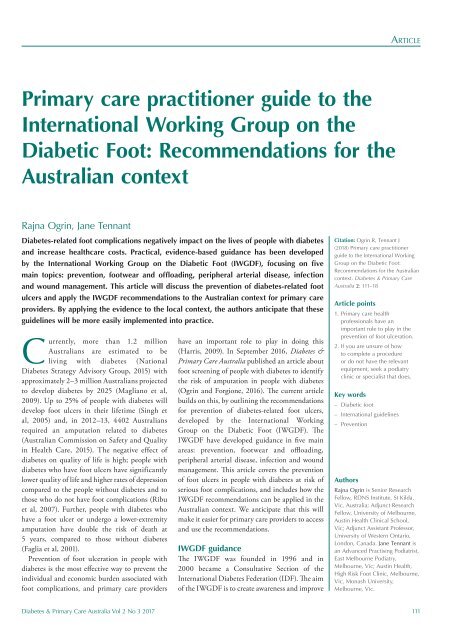DPCA 2-3_entire_v3
You also want an ePaper? Increase the reach of your titles
YUMPU automatically turns print PDFs into web optimized ePapers that Google loves.
Article<br />
Primary care practitioner guide to the<br />
International Working Group on the<br />
Diabetic Foot: Recommendations for the<br />
Australian context<br />
Rajna Ogrin, Jane Tennant<br />
Diabetes-related foot complications negatively impact on the lives of people with diabetes<br />
and increase healthcare costs. Practical, evidence-based guidance has been developed<br />
by the International Working Group on the Diabetic Foot (IWGDF), focusing on five<br />
main topics: prevention, footwear and offloading, peripheral arterial disease, infection<br />
and wound management. This article will discuss the prevention of diabetes-related foot<br />
ulcers and apply the IWGDF recommendations to the Australian context for primary care<br />
providers. By applying the evidence to the local context, the authors anticipate that these<br />
guidelines will be more easily implemented into practice.<br />
Currently, more than 1.2 million<br />
Australians are estimated to be<br />
living with diabetes (National<br />
Diabetes Strategy Advisory Group, 2015) with<br />
approximately 2–3 million Australians projected<br />
to develop diabetes by 2025 (Magliano et al,<br />
2009). Up to 25% of people with diabetes will<br />
develop foot ulcers in their lifetime (Singh et<br />
al, 2005) and, in 2012–13, 4402 Australians<br />
required an amputation related to diabetes<br />
(Australian Commission on Safety and Quality<br />
in Health Care, 2015). The negative effect of<br />
diabetes on quality of life is high; people with<br />
diabetes who have foot ulcers have significantly<br />
lower quality of life and higher rates of depression<br />
compared to the people without diabetes and to<br />
those who do not have foot complications (Ribu<br />
et al, 2007). Further, people with diabetes who<br />
have a foot ulcer or undergo a lower-extremity<br />
amputation have double the risk of death at<br />
5 years, compared to those without diabetes<br />
(Faglia et al, 2001).<br />
Prevention of foot ulceration in people with<br />
diabetes is the most effective way to prevent the<br />
individual and economic burden associated with<br />
foot complications, and primary care providers<br />
have an important role to play in doing this<br />
(Harris, 2009). In September 2016, Diabetes &<br />
Primary Care Australia published an article about<br />
foot screening of people with diabetes to identify<br />
the risk of amputation in people with diabetes<br />
(Ogrin and Forgione, 2016). The current article<br />
builds on this, by outlining the recommendations<br />
for prevention of diabetes-related foot ulcers,<br />
developed by the International Working<br />
Group on the Diabetic Foot (IWGDF). The<br />
IWGDF have developed guidance in five main<br />
areas: prevention, footwear and offloading,<br />
peripheral arterial disease, infection and wound<br />
management. This article covers the prevention<br />
of foot ulcers in people with diabetes at risk of<br />
serious foot complications, and includes how the<br />
IWGDF recommendations can be applied in the<br />
Australian context. We anticipate that this will<br />
make it easier for primary care providers to access<br />
and use the recommendations.<br />
IWGDF guidance<br />
The IWGDF was founded in 1996 and in<br />
2000 became a Consultative Section of the<br />
International Diabetes Federation (IDF). The aim<br />
of the IWGDF is to create awareness and improve<br />
Citation: Ogrin R, Tennant J<br />
(2018) Primary care practitioner<br />
guide to the International Working<br />
Group on the Diabetic Foot:<br />
Recommendations for the Australian<br />
context. Diabetes & Primary Care<br />
Australia 2: 111–18<br />
Article points<br />
1. Primary care health<br />
professionals have an<br />
important role to play in the<br />
prevention of foot ulceration.<br />
2. If you are unsure of how<br />
to complete a procedure<br />
or do not have the relevant<br />
equipment, seek a podiatry<br />
clinic or specialist that does.<br />
Key words<br />
– Diabetic foot<br />
– International guidelines<br />
– Prevention<br />
Authors<br />
Rajna Ogrin is Senior Research<br />
Fellow, RDNS Institute, St Kilda,<br />
Vic, Australia; Adjunct Research<br />
Fellow, University of Melbourne,<br />
Austin Health Clinical School,<br />
Vic; Adjunct Assistant Professor,<br />
University of Western Ontario,<br />
London, Canada. Jane Tennant is<br />
an Advanced Practising Podiatrist,<br />
East Melbourne Podiatry,<br />
Melbourne, Vic; Austin Health,<br />
High Risk Foot Clinic, Melbourne,<br />
Vic, Monash University,<br />
Melbourne, Vic.<br />
Diabetes & Primary Care Australia Vol 2 No 3 2017 111
















